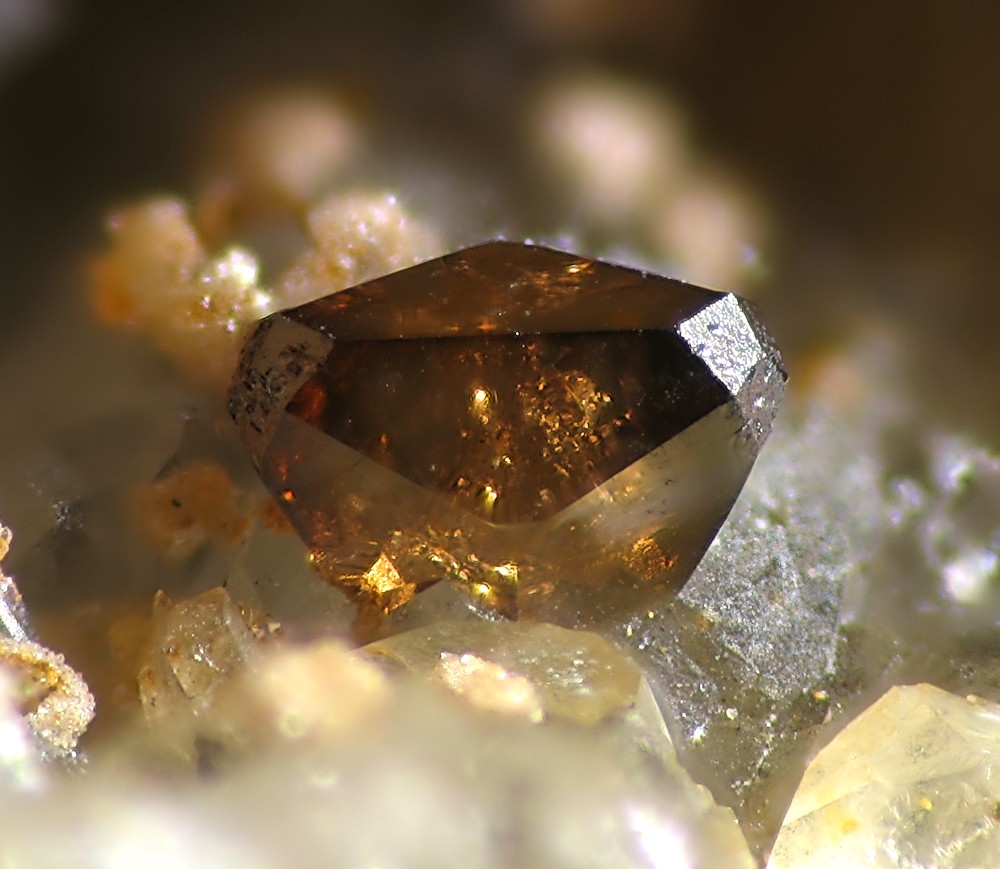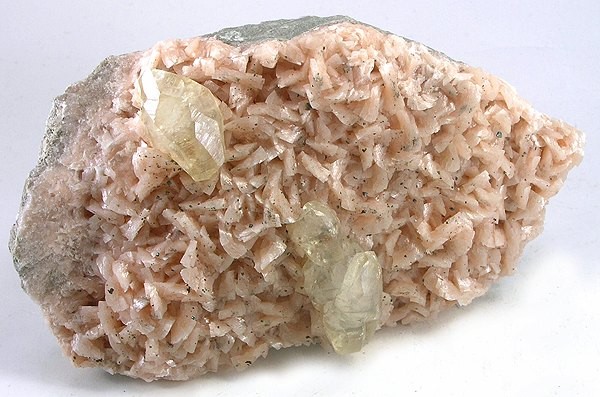|
Eulytine
Eulytine ( from , fusible, easily dissolved) or ''bismuth blende'' (obsolete)''August Breithaupt, Breithaupt A. and Carl Julius Fritzsche, Fritzsche C.'' (1849). Annalen der Physik, Halle, Leipzig: s. 228. is one of the rarest minerals in nature. The composition is bismuth silicate with the calculation formula Bi4(SiO4)3 or Bi4Si3O12. The mineral forms isometric cubic crystals up to 2 mm in size, the supporting form of which is a tetrahedron or tristetrahedron. Among the varieties, there are also often concentric, fibrous or spherical aggregates of a very impressive appearance, which were previously called agricolites. Eulytine is a secondary mineral, a product of the oxidation of bismuth and its compounds.''Vladimir Vernadsky'' Collected works d 24; edited by academician Erik Galimov. — Moscow: Science, 2013 г. — Volume 2. Experience in descriptive mineralogy (1908–1914) — 572 p. Discovery history and name The history of the discovery of the mineral is complex and ... [...More Info...] [...Related Items...] OR: [Wikipedia] [Google] [Baidu] |
Silicate Mineral
Silicate minerals are rock-forming minerals made up of silicate groups. They are the largest and most important class of minerals and make up approximately 90 percent of Earth's crust. In mineralogy, the crystalline forms of silica (silicon dioxide, ) are usually considered to be Silicate mineral#Tectosilicates, tectosilicates, and they are classified as such in the Dana system (75.1). However, the Nickel-Strunz system classifies them as oxide minerals (4.DA). Silica is found in nature as the mineral quartz, and its polymorphism (materials science), polymorphs. On Earth, a wide variety of silicate minerals occur in an even wider range of combinations as a result of the processes that have been forming and re-working the crust for billions of years. These processes include partial melting, crystallization, fractionation, metamorphism, weathering, and diagenesis. Living organisms also contribute to this carbonate–silicate cycle, geologic cycle. For example, a type of plankton ... [...More Info...] [...Related Items...] OR: [Wikipedia] [Google] [Baidu] |
Fracture (mineralogy)
In the field of mineralogy, fracture is the texture and shape of a rock's surface formed when a mineral is fractured. Minerals often have a highly distinctive fracture, making it a principal feature used in their identification. Fracture differs from Cleavage (crystal), cleavage in that the latter involves clean splitting along the cleavage planes of the mineral's crystal structure, as opposed to more general breakage. All minerals exhibit fracture, but when very strong cleavage is present, it can be difficult to see. Terminology Five types of fractures are recognized in mineralogy: conchoidal, earthy, hackly, splintery (or fibrous), and uneven factures. Conchoidal fracture ''Conchoidal fracture'' breakage that resembles the concentric Ripple marks, ripples of a mussel shell. It often occurs in Amorphous solid, amorphous or Granularity, fine-grained mineraloids such as flint, opal or obsidian, but may also occur in Crystal, crystalline minerals such as quartz. ''Subconc ... [...More Info...] [...Related Items...] OR: [Wikipedia] [Google] [Baidu] |
Johanngeorgenstadt
Johanngeorgenstadt (, ) is a mining town in Saxony’s Ore Mountains, 17 km south of Aue, and 27 km northwest of Karlovy Vary. It lies in the district of Erzgebirgskreis, on the border with the Czech Republic, is a state-recognized health resort (''Erholungsort''), and calls itself ''Stadt des Schwibbogens'' (“ Schwibbogen Town”). Its population decline since the 1950s has been extremely severe, falling from 45,000 residents in 1953 to only about one twelfth of that now. Geography Location The town stretches predominantly from the eastern ridge of the almost 900-m-high Fastenberg to where the Breitenbach, which forms part of the border with the Czech Republic, empties into the river Schwarzwasser. The nearest high mountains to the town are the 1019-m-high Auersberg, the 1043-m-high Blatenský vrch (in the Czech Republic) and the 913-m-high Rabenberg. Neighbouring communities Communities in Aue-Schwarzenberg bordering on Johanngeorgenstadt are Breitenbrunn ... [...More Info...] [...Related Items...] OR: [Wikipedia] [Google] [Baidu] |
Schneeberg, Saxony
Schneeberg is a town in Saxony’s district of Erzgebirgskreis. It has roughly 16,400 inhabitants and belongs to the Town League of Silberberg (''Städtebund Silberberg''). It lies 4 km west of Aue, and southeast of Zwickau. Geography Location Schneeberg lies on the Silver Road in the upper western Ore Mountains. Visible from afar is the prominent church of St. Wolfgang. The heart of the town lies on the ''Schneeberg'', which reaches 470 metres above sea level and is also the town’s namesake. Among the surrounding peaks are the ''Gleesberg'' (593 m) to the east and the ''Keilberg'' (557 m) to the north. History Schneeberg’s more than 500-year-long history has been shaped by mining more than anything else, laying the very groundwork for the town’s founding. The original silver mining also yielded cobalt and bismuth mining by the mid 16th century. When uranium mining was being undertaken between 1946 and 1958, the town’s population quickl ... [...More Info...] [...Related Items...] OR: [Wikipedia] [Google] [Baidu] |
Quartz
Quartz is a hard, crystalline mineral composed of silica (silicon dioxide). The Atom, atoms are linked in a continuous framework of SiO4 silicon–oxygen Tetrahedral molecular geometry, tetrahedra, with each oxygen being shared between two tetrahedra, giving an overall chemical formula of Silicon dioxide, SiO2. Quartz is, therefore, classified structurally as a Silicate mineral#Tectosilicates, framework silicate mineral and compositionally as an oxide mineral. Quartz is the second most abundant mineral in Earth's continental crust, behind feldspar. Quartz exists in two forms, the normal α-quartz and the high-temperature β-quartz, both of which are chiral. The transformation from α-quartz to β-quartz takes place abruptly at . Since the transformation is accompanied by a significant change in volume, it can easily induce microfracturing of ceramics or rocks passing through this temperature threshold. There are many different varieties of quartz, several of which are classifi ... [...More Info...] [...Related Items...] OR: [Wikipedia] [Google] [Baidu] |
Metamorphism
Metamorphism is the transformation of existing Rock (geology), rock (the protolith) to rock with a different mineral composition or Texture (geology), texture. Metamorphism takes place at temperatures in excess of , and often also at elevated pressure or in the presence of chemically active fluids, but the rock remains mostly solid during the transformation. Metamorphism is distinct from weathering or diagenesis, which are changes that take place at or just beneath Earth's surface. Various forms of metamorphism exist, including Regional metamorphism, regional, Contact metamorphism, contact, Hydrothermal metamorphism, hydrothermal, Shock metamorphism, shock, and Dynamic metamorphism, dynamic metamorphism. These differ in the characteristic temperatures, pressures, and rate at which they take place and in the extent to which reactive fluids are involved. Metamorphism occurring at increasing pressure and temperature conditions is known as ''prograde metamorphism'', while decreasin ... [...More Info...] [...Related Items...] OR: [Wikipedia] [Google] [Baidu] |
Mineralogy
Mineralogy is a subject of geology specializing in the scientific study of the chemistry, crystal structure, and physical (including optical mineralogy, optical) properties of minerals and mineralized artifact (archaeology), artifacts. Specific studies within mineralogy include the processes of mineral origin and formation, classification of minerals, their geographical distribution, as well as their utilization. History Early writing on mineralogy, especially on gemstones, comes from ancient Babylonia, the ancient Greco-Roman world, ancient and medieval History of China, China, and Sanskrit texts from History of India, ancient India and the ancient Islamic world. Books on the subject included the ''Naturalis Historia, Natural History'' of Pliny the Elder, which not only described many different minerals but also explained many of their properties, and Kitab al Jawahir (Book of Precious Stones) by Persian scientist Al-Biruni. The German Renaissance specialist Georgius Agricola ... [...More Info...] [...Related Items...] OR: [Wikipedia] [Google] [Baidu] |
Crystal Twinning
Crystal twinning occurs when two or more adjacent crystals of the same mineral are oriented so that they share some of the same crystal lattice points in a symmetrical manner. The result is an intergrowth of two separate crystals that are tightly bonded to each other. The surface along which the lattice points are shared in twinned crystals is called a composition surface or twin plane. Crystallographers classify twinned crystals by a number of twin laws, which are specific to the crystal structure. The type of twinning can be a diagnostic tool in mineral identification. There are three main types of twinning. The first is growth twinning which can occur both in very large and very small particles. The second is transformation twinning, where there is a change in the crystal structure. The third is deformation twinning, in which twinning develops in a crystal in response to a shear stress, and is an important mechanism for permanent shape changes in a crystal. Definition T ... [...More Info...] [...Related Items...] OR: [Wikipedia] [Google] [Baidu] |
Pleochroism
Pleochroism is an optical phenomenon in which a substance has different colors when observed at different angles, especially with Polarization (waves), polarized light. Etymology The roots of the word are from Greek (). It was first made compound in the German term ''Pleochroismus'' by mineralogist Wilhelm Haidinger in 1854, in the journal ''Annalen der Physik und Chemie''. Its first known English usage is by geologist James Dana in 1854. Background Anisotropy, Anisotropic crystals will have optical properties that vary with the direction of light. The direction of the electric field determines the polarization of light, and crystals will respond in different ways if this angle is changed. These kinds of crystals have one or two optical axes. If absorption of light varies with the angle relative to the optical axis in a crystal then pleochroism results. Anisotropic crystals have double refraction of light where light of different Polarization (waves), polarizations is bent di ... [...More Info...] [...Related Items...] OR: [Wikipedia] [Google] [Baidu] |
Druse (geology)
In geology and mineralogy, druse is a crystal habit represented by the coating of fine crystals on a rock (geology), rock fracture (geology), fracture surface, or vein (geology), vein or within a vug or geode. See also * Miarolitic cavity References Mineral habits {{petrology-stub ... [...More Info...] [...Related Items...] OR: [Wikipedia] [Google] [Baidu] |
Freiberg
Freiberg () is a university and former mining town in Saxony, Germany, with around 41,000 inhabitants. The city lies in the foreland of the Ore Mountains, in the Saxon urbanization axis, which runs along the northern edge of the Elster and Ore Mountains, stretching from Plauen in the southwest via Zwickau, Chemnitz and Freiberg to Dresden in the northeast. It sits on the Freiberger Mulde, a tributary of the Mulde River. It is a '' Große Kreisstadt'' (large district town), and the administrative seat of ''Landkreis Mittelsachsen'' (district Central Saxony). Freiberg is connected to Dresden by the S3 line of the Dresden S-Bahn. The entire historic center of the Silver City is under monument protection, and together with local monuments of mining history such as the ''Reiche Zeche'' ore mine, it has been part of the UNESCO World Heritage Site Erzgebirge/Krušnohoří Mining Region since 2019 due to its exceptional testimony to the development of mining techniques across ... [...More Info...] [...Related Items...] OR: [Wikipedia] [Google] [Baidu] |








